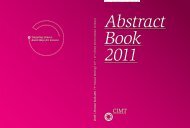Abstract Book 2010 - CIMT Annual Meeting
Abstract Book 2010 - CIMT Annual Meeting
Abstract Book 2010 - CIMT Annual Meeting
You also want an ePaper? Increase the reach of your titles
YUMPU automatically turns print PDFs into web optimized ePapers that Google loves.
088 Schmid | Tumor biology & interaction with the immune system<br />
Development of a novel transgenic mouse model for melanoma<br />
Beate Schmid 1 , Danielle Arnold-Schild 1 , Mustafa Diken 2 , Christine Tertilt 1,3 , Markus Radsak<br />
4 , Hansjörg Schild 1<br />
1 Johannes Gutenberg University Medical Center, Dept. of Immunology,<br />
Langenbeckstr. 1, 55131 Mainz, Germany<br />
2 Johannes Gutenberg University Medical Center, III. Dept. Medicine, Hematology/Oncology,<br />
Obere Zahlbacher Str. 63, 55131 Mainz, Germany<br />
3 Johannes Gutenberg University Medical Center, Dept. of Pediatrics,<br />
Langenbeckstr. 1, 55131 Mainz, Germany<br />
4 Johannes Gutenberg University Medical Center, III. Dept. Medicine, Hematology/Oncology,<br />
Langenbeckstr. 1, 55131 Mainz, Germany<br />
Novel cancer therapeutics need to be evaluated<br />
in animal models before application in humans.<br />
Models using transplanted tumor cell lines may lead<br />
to tumor growth in mice, but their characteristics<br />
often substantially differ from autochthonously developing<br />
tumors in vivo. This may be important for<br />
the development of tumor tolerance and the establishment<br />
of anti-tumor immunity. Therefore, new<br />
animal models are needed where the endogenous<br />
development of tumors can be controlled and manipulated.<br />
To create an autochthonous tumor model<br />
we generated BAC transgenic mice with inducible<br />
expression of the melanoma oncogenes BrafV600E,<br />
Cdk4R24C and Mitf under the control of the melanocyte<br />
specific tyrosinase promoter. Furthermore<br />
we introduced the gene for firefly luciferase for monitoring<br />
of oncogene expression by bioluminescent<br />
imaging. Transcription of these genes is controlled<br />
by the tamoxifen inducible recombinase CreERT2<br />
also expressed specifically in melanocytes. In vitro<br />
studies of C22 cells transfected with the vector<br />
pcDNA3.1 containing the oncogene-luciferase expression<br />
construct indeed showed an increase in<br />
Braf and Cdk4 expression by western blot as well<br />
as luciferase activity indicating the functionality<br />
of the construct. The pronucleus injection of the<br />
final BAC construct resulted in three founders confirmed<br />
by PCR and southern blot analysis. Analysis<br />
of these mouse lines in vivo by bioluminescent<br />
imaging showed some base line luciferase activity<br />
in one mouse line indicating leakiness of the trans-<br />
genic construct. However, tamoxifen treatment<br />
greatly enhanced the luciferase activity indicating<br />
that our construct is operating as intended. Further<br />
analyses to characterize the tissue specific transgene<br />
expression and kinetics of tumor development<br />
are ongoing. After completion of these basic studies<br />
this novel mouse model will be a valuable tool for<br />
the preclinical assessment of novel cancer therapeutics.<br />
137



